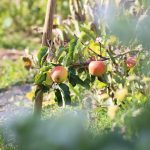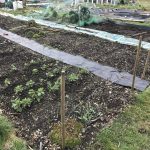Our London garden in Clapham was approximately 20m (66ft) above sea level, our new garden sits at almost 302m (1,000ft) above sea level. To put this into context, the Shard building in London is 310m tall. Our new elevation places us high enough to be standing above the clouds on some days. I knew this would have various impacts on how and what plants we grow but why? I’ve explored the main ways a higher altitude garden impacts plants below.
1) Air pressure
The higher your garden’s elevation, the lower the air pressure. Air pressure has an effect on plant growth in a number of ways. Lower air pressure has less carbon dioxide, which plants need to grow, and it also means a slower rate of transpiration. Undoubtedly this will slow the rate of photosynthesis and plant growth, something I’ve seen happening in our new garden. Certain plants I’m very familiar with such as Cosmos and Ammi are at least a month or more behind gardens lower down. At the start of spring when tree leaf growth was slower, this could have been put down to temperature but since the start of summer, temperatures haven’t been that different – the biggest difference is air pressure. The plants are growing in a sheltered enclosed area of the garden where wind is less of a factor. You can choose plants that have evolved to life at a higher altitude and even collect seeds from plants like peas and beans to gradually breed plants that show stronger growth in these conditions. Air pressure will ultimately have an effect on the size of the plant in conjunction with other factors below. The higher a plant, the more compact it will grow, though we’re unlikely to notice the difference at 300m, and size is also influenced by factors such as nutrients available, and our soil is extremely fertile.
2) Light
Being higher impacts light in a number of ways. The intensity of light will be stronger due to the thinner atmosphere, and light radiation levels slightly higher too. Thanks to the height of our hill, we also have more hours of sunlight than lower down in the valley where the sun sets earlier due to the angles, particularly in winter when the sun is lower in the sky. Higher light levels at our altitude will generally increase photosynthesis resulting in strong plant growth. Go higher and plants will need more protection from the scorching sun. Naturally plants have evolved adaptations to this such as silver or lighter leaves to reflect the light and hairs to protect the leaf.
3) Temperature
Being higher generally means lower air temperatures, due to wind and air movement of course, but also largely because of air pressure. The molecules in air bump into each other creating some warmth but with thinner air at higher elevations there are fewer molecules. Fewer air molecules means less bumping and friction to create warmth. Temperature impacts plants because they grow best at certain temperatures. Exactly what temperature growth is fastest at will depend on the plant itself, and many are adapted to colder temperatures. When temperatures go too high, this can also slow plant growth as the plant effectively shuts down to conserve moisture. But let’s say, as an example, plant growth is optimum between 10 – 25C, generally the higher the temperature in the range, with good light, nutrients, CO2 levels and water, a plant will grow at its fastest. E.g. a plant at 25C can grow faster than one at 20C if all other factors are the same. So even a slight drop in temperature due to altitude can cause plant growth to be slower than a plant lower down the hill and a few degrees warmer.
4) Wind
We all know wind has an impact on plant growth when strong gusts blow our favourite plants over, but it has an impact in a less visible way. The air around plants will have varying levels of humidity and this impacts how much water is lost from the plant. Plants absorb water through their roots which is transported up to their leaves via the process of transpiration where water evaporates from the surfaces of their leaves, they do this to transport nutrients through the plant for photosynthesis. Depending on how humid the air is, the plant will speed up or slow down transpiration because of diffusion. Diffusion is the process of molecules moving from an area of high concentration of those molecules to one of low concentration. When you spray perfume at one end of a room, diffusion carries it to the other end. In a plant’s case, water molecules evaporating into the oxygen and carbon dioxide molecules of air. If air has higher humidity with higher concentrations of water, the slower the diffusion from the leaf. The drier the air and lower humidity, the faster the diffusion and transpiration. When it’s windy, humidity decreases and water is drawn from the plant faster – unless of course it’s a high humidity rainy day. Winds can cause transpiration to happen much faster which is noticeable most in pot plants because they can dry out very quickly on windy days. In our new garden at 1,000ft, wind will be having an effect on plants. On warmer days sometimes causing them to close their pores to slow transpiration and growth. In addition to water effects, wind will make plants stockier with increased rocking, causing them to react with shorter, stronger stems. You see this sometimes with trees bonsai’d in exposed spots from wind. Some plants, such as garden alpines, have also evolved to protect from wind, and leaf hairs help keep humidity in around the leaf surface by shielding from wind.
5) Humidity
As discussed above, humidity impacts on plant growth through its effects on transpiration. At higher altitudes the air is often drier naturally, especially the higher you go. Unless a low-cloud is passing over which is essentially the highest humidity air you can get. I’d say our garden is at a height where the air can be dry on hot, windy summer days but is generally always very humid. This is because of the high water content draining in the soil from the moors above down to us, the location of our hill range and amount of rainfall we receive.
6) Drainage
Gardening high up usually (but not always) means you’re likely to be on a slope of some kind. This probably means the garden has good drainage as water runs downhill. This can be a problem for some because in summer, the soil can dry out completely very quickly. Less water means slower plant growth. However, this isn’t a problem in our garden because of the high number of natural springs, water drainage from above and retention in soils.
7) Water
The higher your altitude, generally the more precipitation there is because the atmosphere can’t hold as much moisture, releasing it as rainfall. If you’re on a hill or mountain, the side you’re situated on will have an effect too because the side facing the prevailing wind will receive most precipitation. In our garden I can confirm that it indeed does rain a lot! I’ve found it interesting just how much water there is, with high levels of water retained in the ground and water coming from higher up the hill, it means I barely have to water at all. There is also a lot of dew in the mornings because of the water in the ground creating high humidity and because of the plants themselves releasing excess water through the edges of their leaves, a process called guttation. Dew here can be so heavy it’s like there’s been a heavy downpour when it hasn’t rained for weeks.
Summary
All of these factors will have varying degrees of influence on plant growth that differs through the seasons and with different weather conditions. We’ve only been on our farm since the end of February 2021, we haven’t had a full year yet, but I have noticed almost all plants spend more time establishing roots with slow above ground growth. They then suddenly shoot upwards when they’re finally happy, growing faster than I’m used to. It’s a strange pattern to me, rather than a gradual growth, the plants sit for ages leaving me wondering what’s happening before suddenly springing into action.




Never ever considered CO2 – this was an eye-opener thanks!
Fascinating and very useful. Do you know at what altitude things might be noticeably affected?
It really depends on the situation and climate, it’s a sliding scale so the greater the distance you are from the base, the greater difference you’ll notice. The best thing is to go for the same walk in your area through the seasons to spot the differences in plant growth and timings.